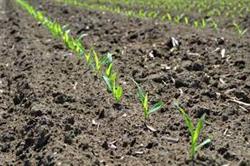The Pro's and Con's of Planting Early

Traditionally, a majority of Indiana’s corn crop is planted between April 20th and May 10th, give or take a week here in the northern part of the state. This year however, we are experiencing a drier than usual spring and above average temperatures and field activity has picked up significantly earlier than in years past. So when is the ideal date to plant corn? Each year is a little different, and hindsight will always be 20/20, but farmers are weighing a few pro’s and con’s as they consider when this year’s crop is going into the ground.
Even with close to ideal conditions during the first week of April, there are some risks involved as well. The forecast doesn’t look too bad in the coming days, but as I write this it does look like there will be some more seasonable cool and cloudy days ahead. Corn that is already in the ground will run the risk of taking a long time to germinate and emerge, leaving the seedling vulnerable to damage from disease, insects and weather. It may also lead to uneven emergence throughout a field, leading to pollination concerns later in the season.
That being said, we usually never know the ideal planting date of a crop without hindsight, and there are potential advantages of planting this early. For example, if our weather patterns continue to be on the drier side, perhaps right now is when those seedling have the best chance of obtaining the needed soil moisture for germination. Only time will tell. Early planting will also allow for a longer growing season, and the potential for the crop to pollinate earlier in the season which usually means it will do so under fewer weather stresses.
While important, the planting date is one of many factors that will influence a crops potential throughout the season, and is each grower’s decision. According to Purdue Extension Corn Specialist Bob Nielsen, there are a few things one can do to help hedge their bet with an early planted crop: 1) Within reason, try to wait until soil temperatures are consistently greater than 50 degrees F. 2) Avoid field work when soil conditions will lead to compaction, causing problems later in the growing season. 3) Plant your best quality seed with the highest vigor ratings first. 4) Consider using a seed that is treated with an insecticide to help protect the seed as it sits in the ground.
We have a long season and this will be one of many decisions farmers will face as it goes on. For timely articles and answers to questions as we go along, I would highly recommend subscribing to Purdue’s Chat n’ Chew Café, which is maintained by Dr. Nielsen and can be found here: https://www.agry.purdue.edu/ext/corn/cafe/

